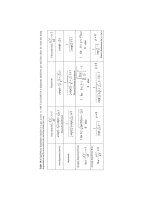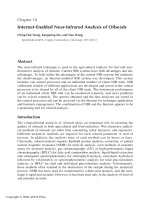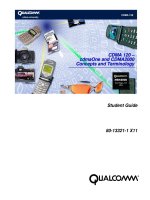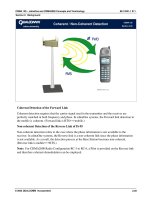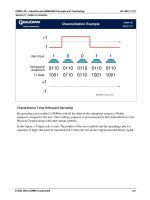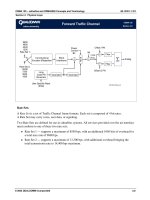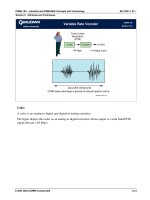CDMA 120 – cdmaOne and CDMA2000 Concepts and Terminology phần 10 pot
Bạn đang xem bản rút gọn của tài liệu. Xem và tải ngay bản đầy đủ của tài liệu tại đây (1.33 MB, 22 trang )
CDMA 120 – cdmaOne and CDMA2000 Concepts and Terminology
Section 8: CDMA2000 Overview
80-13321-1 X11
© 2002 QUALCOMM Incorporated
8-35
CDMA 120
Section 8-35
cdma university
Forward Link Operation
Variable rate
(Full, 1/2, 1/4, 1/8)
Scheduled rate
On/off
Full Rate
1/4 Rate
1/2 Rate
Fundamental
Channel
(F-FCH)
Supplemental
Channel 1
(F-SCH1)
Dedicated
Control Channel
(F-DCCH)
Forward Link Operation
The figure above shows the operation of the F-FCH, F-SCH1, and F-DCCH channels. The
scheduled rate of the F-SCH1 varies as a function of time, as does the rate of the F-FCH. In the
example above, the F-DCCH channel is used to schedule the data rate of the F-SCH1 and is
operated in Discontinuous Transmit (DTX) mode.
CDMA 120 – cdmaOne and CDMA2000 Concepts and Terminology
Section 8: CDMA2000 Overview
80-13321-1 X11
© 2002 QUALCOMM Incorporated
8-36
CDMA 120
Section 8-36
cdma university
Reverse Link Characteristics
z Channels are primarily code multiplexed
– Separate channels used for different Quality of
Service (QoS) and Physical Layer characteristics
z Code multiplexed channels are orthogonalized by
Walsh functions and I/Q split so that performance is
equivalent to BPSK
z Hybrid Combination of QPSK and Pi/2 BPSK
– By restricting alternate phase changes of the
complex scrambling sequence, power peaking is
reduced (1 dB improvement) and side lobes are
narrowed
Notes
CDMA 120 – cdmaOne and CDMA2000 Concepts and Terminology
Section 8: CDMA2000 Overview
80-13321-1 X11
© 2002 QUALCOMM Incorporated
8-37
CDMA 120
Section 8-37
cdma university
Reverse Link Characteristics (continued)
z Code multiplexed channels
– Walsh sequences separate Physical Channels
z Forward Error Correction
– Convolutional codes (K=9) are used for voice and data
– Turbo codes (K=4) are used for high data rates on
Supplemental
z Fast Reverse Power Control
– 800 Hz update rate
z Frame lengths
– 5 ms, 10 ms, 20 ms, 40 ms, and 80 ms frames
Notes
CDMA 120 – cdmaOne and CDMA2000 Concepts and Terminology
Section 8: CDMA2000 Overview
80-13321-1 X11
© 2002 QUALCOMM Incorporated
8-38
CDMA 120
Section 8-38
cdma university
REVERSE CDMA CHANNEL
for Spreading Rates 1 and 3 (SR1 and SR3)
Access
Channel
Reverse
Traffic
Channel
(RC 1 or 2)
Enhanced
Access
Channel
Operation
Reverse
Common
Control
Channel
Operation
Reverse
Traffic
Channel
Operation
(RC 3 to 6)
Reverse
Fundamental Channel
Reverse
Pilot Channel
Reverse
Pilot Channel
Reverse
Pilot Channel
0to7Reverse
Supplemental
Code Channels
Enhanced Access
Channel
Reverse Common
Control Channel
0or1Reverse
Dedicated Control
Channel
0or1Reverse
Fundamental Channel
0to2Reverse
Supplemental
Channels
Reverse
Power Control
Subchannel
Backward-Compatible Channels
ReverseLinkChannels
Reverse Link Channels
The CDMA2000 Reverse Link Channels are:
z Access Channel (R-ACH)
z Reverse Pilot Channel (R-PICH)
z Enhanced Access Channel (R-EACH)
z Reverse Common Control Channel (R-CCCH)
z Reversed Dedicated Control Channel (R-DCCH)
z Reverse Fundamental Channel (R-FCH)
z Reverse Supplemental Channel (R-SCH)
z Reverse Supplemental Code Channel (R-SCCH)
The Access Channel and Reverse Supplemental Channel are retained for backward compatibility
with TIA/EIA-95A/B. For Radio Configurations 1 and 2, the channel structure for the Reverse
Fundamental Channel and Reverse Supplemental Channel is the same as the channel structure of
Rate Set 1 and Rate Set 2 used in TIA/EIA-95A/B.
CDMA 120 – cdmaOne and CDMA2000 Concepts and Terminology
Section 8: CDMA2000 Overview
80-13321-1 X11
© 2002 QUALCOMM Incorporated
8-39
CDMA 120
Section 8-39
cdma university
REVERSE CDMA CHANNEL
for Spreading Rates 1 and 3 (SR1 and SR3)
Access
Channel
Reverse
Traffic
Channel
(RC 1 or 2)
Enhanced
Access
Channel
Operation
Reverse
Common
Control
Channel
Operation
Reverse
Traffic
Channel
Operation
(RC 3 to 6)
Reverse
Fundamental Channel
Reverse
Pilot Channel
Reverse
Pilot Channel
Reverse
Pilot Channel
0to7Reverse
Supplemental
Code Channels
Enhanced Access
Channel
Reverse Common
Control Channel
0or1Reverse
Dedicated Control
Channel
0or1Reverse
Fundamental Channel
0to2Reverse
Supplemental
Channels
Reverse
Power Control
Subchannel
Common Channels
Dedicated Channels
Reverse Common and Dedicated Channels
Reverse Common and Dedicated Channels
Reverse Link Common Channels are used by multiple mobiles primarily for a brief exchange of
information between a mobile and a Base Station. The Reverse Link Common Channels are:
z Access Channel (R-ACH)
z Enhanced Access Channel (R-EACH)
z Reverse Common Control Channel (R-CCCH)
Reverse Link Dedicated Channels are assigned to a single mobile for the duration of a call. The
Reverse Link Dedicated Channels include:
z Reverse Dedicated Control Channel (R-DCCH)
z Reverse Fundamental Channel (R-FCH)
z Reverse Supplemental Channel (R-SCH)
z Reverse Supplemental Code Channel (R-SCCH)
The Reverse Pilot Channel is used with both Common and Dedicated Channels.
CDMA 120 – cdmaOne and CDMA2000 Concepts and Terminology
Section 8: CDMA2000 Overview
80-13321-1 X11
© 2002 QUALCOMM Incorporated
8-40
CDMA 120
Section 8-40
cdma university
Illustration of Reverse Link Operation
Reverse Link Operations
The Reverse link Pilot is always active and different channels may be transmitted as long as the
mobile transmitter has sufficient power. The channel power is a function of the data rate, FEC, and
frame length.
